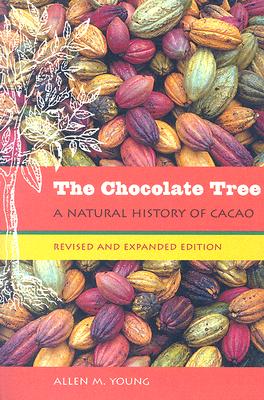The Chocolate Tree: A Natural History of Cacao

The Chocolate Tree: A Natural History of Cacao
Young provides an overview of the fascinating natural and human history of one of the world's most intriguing commodities: chocolate. Cultivated for over 1,000 years in Latin America and the starting point for millions of tons of chocolate annually consumed worldwide, cacao beans have been used for beverages, as currency, and for regional trade. After the Spanish brought the delectable secret of the cacao tree back to Europe in the late 16th century, its seeds created and fed an insatiable worldwide appetite for chocolate. The Chocolate Tree chronicles the natural and cultural history of Theobroma cacao and explores its ecological niche. Tracing cacao's journey out of the rain forest, into pre-Columbian gardens, and then onto plantations adjacent to rain forests, Young describes the production of this essential crop, the environmental price of Europeanized cultivation, and ways that current reclamation efforts for New World rain forests can improve the natural ecology of the cacao tree. Amid encounters with sloths, toucans, butterflies, giant tarantula hawk wasps, and other creatures found in cacao groves, Young identifies a tiny fly that provides a vital link between the chocolate tree and its original rain forest habitat. This discovery leads him to conclude that cacao trees in cultivation today may have lost their original insect pollinators due to the plant's long history of agricultural manipulation.In addition to basic natural history of the cacao tree and the relationship between cacao production systems and the preservation of the rain forest, Young also presents a history of the use of cacao, from the archaeological evidence of Mesoamerica to contemporary evidence of the relationship between chocolate consumption and mental and physical health.A rich concoction of cultural and natural history, archaeological evidence, botanical research, environmental activism, and lush descriptions of a contemporary adventurer's encounters with tropical wonders, The Chocolate Tree offers an appreciation of the plant and the environment that provide us with this Mayan "food of the gods."
PRP: 154.69 Lei
Acesta este Prețul Recomandat de Producător. Prețul de vânzare al produsului este afișat mai jos.
123.75Lei
123.75Lei
154.69 LeiLivrare in 2-4 saptamani
Descrierea produsului
Young provides an overview of the fascinating natural and human history of one of the world's most intriguing commodities: chocolate. Cultivated for over 1,000 years in Latin America and the starting point for millions of tons of chocolate annually consumed worldwide, cacao beans have been used for beverages, as currency, and for regional trade. After the Spanish brought the delectable secret of the cacao tree back to Europe in the late 16th century, its seeds created and fed an insatiable worldwide appetite for chocolate. The Chocolate Tree chronicles the natural and cultural history of Theobroma cacao and explores its ecological niche. Tracing cacao's journey out of the rain forest, into pre-Columbian gardens, and then onto plantations adjacent to rain forests, Young describes the production of this essential crop, the environmental price of Europeanized cultivation, and ways that current reclamation efforts for New World rain forests can improve the natural ecology of the cacao tree. Amid encounters with sloths, toucans, butterflies, giant tarantula hawk wasps, and other creatures found in cacao groves, Young identifies a tiny fly that provides a vital link between the chocolate tree and its original rain forest habitat. This discovery leads him to conclude that cacao trees in cultivation today may have lost their original insect pollinators due to the plant's long history of agricultural manipulation.In addition to basic natural history of the cacao tree and the relationship between cacao production systems and the preservation of the rain forest, Young also presents a history of the use of cacao, from the archaeological evidence of Mesoamerica to contemporary evidence of the relationship between chocolate consumption and mental and physical health.A rich concoction of cultural and natural history, archaeological evidence, botanical research, environmental activism, and lush descriptions of a contemporary adventurer's encounters with tropical wonders, The Chocolate Tree offers an appreciation of the plant and the environment that provide us with this Mayan "food of the gods."
Detaliile produsului









